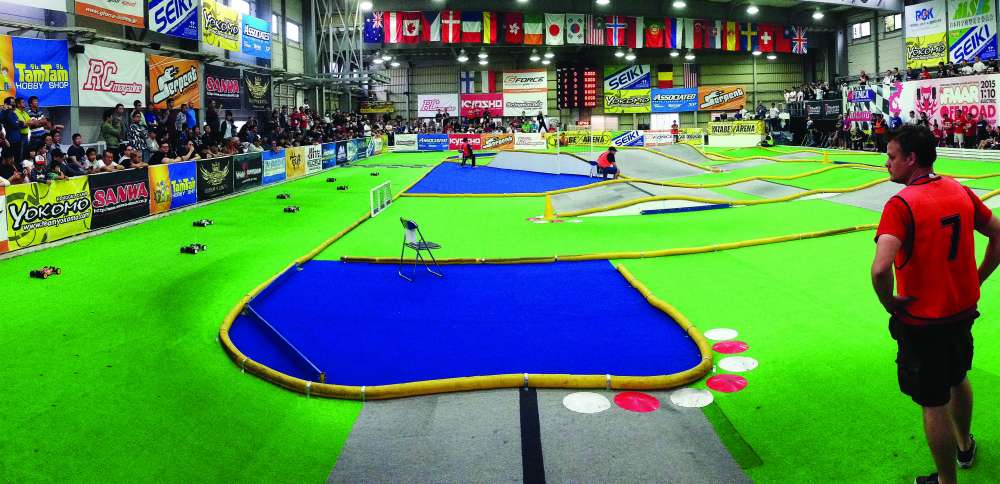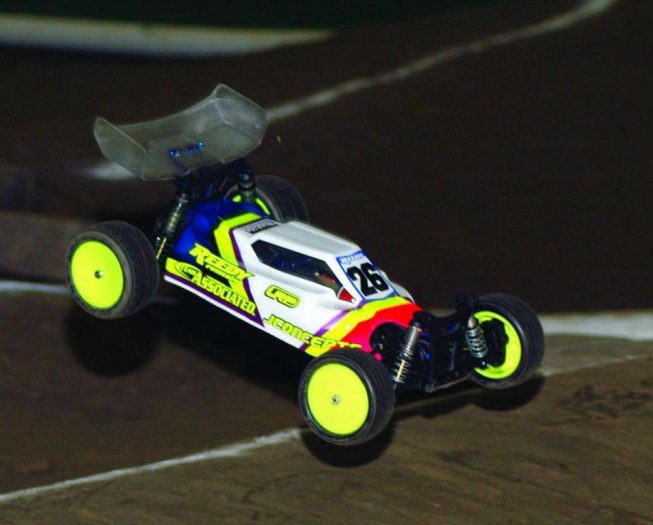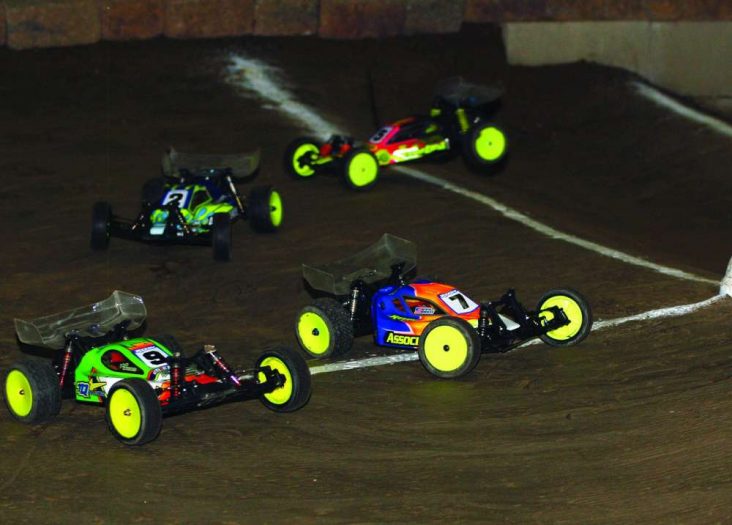This article was originally published in RC Driver’s October 2016 issue.

A few months ago I wrote about how vehicles in the 2WD buggy class have changed over the years by giving a small profile on each vehicle that won at the IFMAR off-road World Championships. This time I’ll explore track surfaces used at these elite races. I hope to figure out if tracks changed due to the cars, or if cars changed due to tracks.
When the term off-road is mentioned people almost immediately think of tracks made of dirt with a variety of bumps and jumps. For a great many years this was the case and from 1985 – 1991 most tracks were just that. Due to the dirt/loam style surface tracks needed constant maintenance to help them remain consistent and were watered often. To help lessen the amount of maintenance, some track owners turned to clay as it stood the test of time better and in 1993 the Worlds took place on clay. The worlds went back to a more traditional dirt surface from 1995 – 2005 although the track surface tended to be more compacted. In 2007 the Worlds were back on clay, then back to dirt in 2009, back to clay in 2011 and then dirt again in 2013. At some point during this period tracks began using sugar, calcium chloride and other chemicals to help tracks hold together much better and while there were plenty of jumps, bumps and ruts were much less frequent.
The most recent IFMAR Worlds held in Japan were a complete departure from what had been done in the past and took place on green AstroTurf. While some objected to this, and even voted against it, nobody boycotted the event and it was successful. With an AstroTurf track there is next to no maintenance and changing the track design/ layout is as easy as picking up and moving jumps and pipes. Much easier than using heavy equipment needed to change a dirt or clay track.
 Since I was still not clear as to why things changed I went to an industry expert, Todd Hodge of Team Losi Racing to get his take on the evolving landscape of off road racing. Here is his history lesson for us to share:
Since I was still not clear as to why things changed I went to an industry expert, Todd Hodge of Team Losi Racing to get his take on the evolving landscape of off road racing. Here is his history lesson for us to share:
I believe the tracks have evolved to suit the track owners to avoid the constant track maintenance. In the late 1980’s and into the 1990’s we were using large pin tires with some sort of ribbed front tire on 2WD vehicles. It wasn’t until 1993 when we were introduced to having inserts in our tires due to the softer compounds such as Pro-Line’s M2 and Team Losi’s Gold Compound.
Tracks would tend to break apart to the point where races would have to adjust their lines to get competitive lap times. Then, during the mid-late 1990’s we started seeing the pins on tires become much smaller, similar to Proline’s Square Fuzzie that was introduced in 1995 when Matt Francis won the IFMAR World Championships on this tread pattern.
 Then during the early 2000’s we started experiencing tracks that were so smooth and had so much grip that it was faster to run completely worn out tires and, eventually, slicks. During this time all of the manufacturers were trying to put the motor, on rear motor cars, as far forward as possible to move the weight bias toward the front. Then as we progressed through the new millennium we saw one company, which I tip my hat off to, go mid motor. X-Factory out of Ohio started making conversion kits for the AE 2WD buggy. Quite honestly, the guys at X-Factory are the founding fathers of present day mid motor buggies. This chassis was competitive on all of the EU grass and astroturf tracks due to its corner speed. It was somewhat competitive in the U.S. on some of the higher grip tracks such as the Cactus and the Hot Rod Shootout but severely lacked on the lower grip tracks. To me this was a point in time when the cars started to accommodate the tracks as racers tried whatever they could to make their cars faster on these higher grip tracks.
Then during the early 2000’s we started experiencing tracks that were so smooth and had so much grip that it was faster to run completely worn out tires and, eventually, slicks. During this time all of the manufacturers were trying to put the motor, on rear motor cars, as far forward as possible to move the weight bias toward the front. Then as we progressed through the new millennium we saw one company, which I tip my hat off to, go mid motor. X-Factory out of Ohio started making conversion kits for the AE 2WD buggy. Quite honestly, the guys at X-Factory are the founding fathers of present day mid motor buggies. This chassis was competitive on all of the EU grass and astroturf tracks due to its corner speed. It was somewhat competitive in the U.S. on some of the higher grip tracks such as the Cactus and the Hot Rod Shootout but severely lacked on the lower grip tracks. To me this was a point in time when the cars started to accommodate the tracks as racers tried whatever they could to make their cars faster on these higher grip tracks.
Now fast forward a few years into 2013, TLR’s Dakotah Phend won the 2WD Modified ROAR National Championship in Chico, CA on A-Main Hobbies “Sugared” track with a rear motor 2WD buggy. We went back to the IFMAR WC a few months later only to see Dakotah miss the A-main with the same car that he won the ROAR Nationals with a few months prior. Well, to me this was the end of an era of rear motor cars. Why? It’s because the rear motor car lacked corner speed compared to the mid motor cars.
Nowadays most tracks stay in for long periods of time, due the work that’s needed to rebuild them and now the tread patterns of tires are very low profile. With these low profile treaded tires there is no lug/pin flex that used to help the car steer versus the days of stud and step pin type tires. This has resulted in the manufacturers trying to find the fastest way around the track, which led to the development of mid-motor cars by everyone. This development continues even with the new lay down transmission conversion kits that we see companies coming out with. All of this to accommodate the types of tracks we currently run on.
 To conclude, I say that the cars have changed to accommodate the new style tracks that are high packed, loaded with traction with either the choice of dirt or conditioned with sugar water or from I hear out of Las Vegas weeks ago, glue! All of this will be interested to see where 1/8 Nitro will head. Will we start seeing lay down engines or engines mounted further forward for the IFMAR World Championships later this year? Only time will tell.
To conclude, I say that the cars have changed to accommodate the new style tracks that are high packed, loaded with traction with either the choice of dirt or conditioned with sugar water or from I hear out of Las Vegas weeks ago, glue! All of this will be interested to see where 1/8 Nitro will head. Will we start seeing lay down engines or engines mounted further forward for the IFMAR World Championships later this year? Only time will tell.
Coming from someone like Todd Hodge I will have to defer to his wealth of knowledge and experience and agree that because tracks changed manufacturers designed new cars. In addition, track owners, who were looking to make better tracks, that needed less maintenance were really the catalysts to the cars that manufacturers produce today.
 RC Driver The Best In RC Car & Truck News, Reviews & Video
RC Driver The Best In RC Car & Truck News, Reviews & Video 








Dean this was a very informative article. Thanks for the research. Good call on the interview with Todd.
If you see no loose dust and dirt flying it is not offroad in my opinion. Carpet tracks and hard-packed dirt tracks that are so firm cars leave rubber marks on them are a travesty. Just go full asphalt already and use touring cars with more suspension travel …
I understand that at this kind of competitive level having a more consistent track is ideal. But as a spectator I find it way more boring. RC company are now like car companies, racing in ridiculous controlled environment trying to shave that 0.001sec … Honestly I rather see slower lap time in dirt on a changing track, sure you have to change your lines, but hell, its part of the game. Nothing like seeing the top 3 cross side in a curve slinging dirt all over the place battling for TQ….